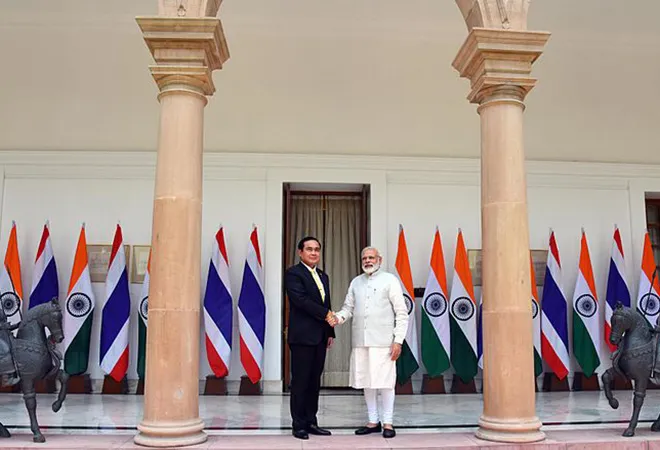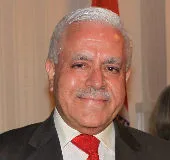
India and Thailand are today celebrating 70 years of establishment of bilateral diplomatic relations which were formalised soon after India achieved independence in 1947. Over the last several years, relations with Thailand have shown considerable growth in diverse fields over the last several years. Immense untapped potential still exists which remains to be harnessed.
Of course, relations between India and Thailand are not of recent origin. Religious, cultural, linguistic, mythological and trade links have existed for over two millennia. References are found in ancient Indian literature characterising Thailand as Swarnabhumi or the Golden Land. Hindu influence reached Thailand over 2,000 years ago, soon after senior monks Sona Thera and Uttara Thera were sent by Emperor Ashoka to spread the gospel of Lord Buddha in 3rd Century BCE. Hindu influence is clearly visible in Thailand’s religious practices, customs, traditions, deity worship, architecture of palaces and temples (wats), in the arts, sculpture, dance, drama, and literature. Royal coronation ceremonies are conducted with Brahmanical rites, and Thai monarchs of the current Chakri dynasty have adopted the title of “Rama” on ascending the throne (the present King, His Majesty Maha Vajiralongkorn is Rama X).
Several other socio-cultural habits and festivals of Thai and Indian people are similar. The Thai lore of Ramakien, a local version of Ramayana, and the wisdom of Lord Buddha bind the peoples together. Loy Krathong and Songkran are inspired by the two major Indian festivals Deepavali and Holi. The 800-year-old connection between the Tai people and Ahoms of North East India has served as an enduring link.
In more recent times, King Chulalongkorn or Rama V paid a royal visit to India in 1872. In 1915, another royal visit of King Vajiravudh (Rama VI) took place.
During Cold War years, Southeast Asia, including Thailand, did not figure prominently on India’s strategic map or economic calculus. There are many reasons for India’s relative neglect of this region during this period. Because of its colonial links, India’s ruling elite had an essentially Western orientation in the post-1947 period. Economically, due to the fact that Southeast Asia was less developed than India until the 1970s, it was not an attractive trading and economic partner. India’s own economic policies were insular and protectionist. It did not help that India’s overland linkages to Southeast Asia were blocked. Myanmar closed itself to the rest of the world in the early sixties while East Pakistan/Bangladesh was not amenable to providing transit facilities. Politics too intervened. India and the Southeast Asian countries were on opposing sides of the Cold War divide.
The paucity of high level contacts between India and Thailand is visible from the fact that from the period starting in 1947 till 1992, there were only two, extremely short, prime ministerial visits from Thailand to India. In 1983, Prime Minister General Prem Tinsulanonda visited Pakistan, Bangladesh and Nepal, but not India.
From India the only prime ministerial visit to Thailand during this period was that of Rajiv Gandhi in 1986.
Notwithstanding the historical ties between the two countries, India King Rama IX Bhumibol Adulyadej did not visit India, although he and Queen Sirikit visited several countries, including Pakistan, during their extended world tours from 1959 to 1967.
Look East Policy
India’s economic and financial crisis of 1991 coincided with the collapse of the Soviet Union, which was India’s valued economic and strategic partner. Both these developments compelled India to take a fresh look at its foreign policy. Prime Minister Narasimha Rao’s strategic vision grasped the changed economic and strategic paradigms of international relations in the early 1990s. New Delhi’s “Look East Policy” and Bangkok’s “Look West Policy,” launched in 1996, converged to bolster economic and trade links.
Highlight of recent years under the LEP was visit by Thai Prime Minister Yingluck Shinawatra as chief guest at India’s Republic Day celebrations in 2012. She visited India again in December that year to participate in the Commemorative Summit held to mark 20 years of the Dialogue Partnership between India and ASEAN. Dr Manmohan Singh, the then Prime Minister, visited Thailand in May 2013 on a two-day bilateral visit. All these visits and interactions provided a strong fillip to bilateral partnership. Bilateral trade rapidly rose to more than US$9 billion per annum from 2012-13 to 2014-15. Trade diminished after that to about US$8.5 billion in 2015-16 on account of decline in the international economy.
In 2003, Thailand emerged as the first ASEAN country to establish a bilateral Free Trade Area (FTA) with India. The early harvest scheme of 2004, in which tariffs on 82 items (2 more items were added later) were slashed, proved to be harmful to the Indian industry. This made Indian business and government apprehensive about opening up the market to more Thai goods. It will be necessary to arrive at a comprehensive yet balanced bilateral trade deal so that it wins the confidence of trade and industry of both the countries. Conclusion of the elusive FTA should be the topmost priority of both the countries.
In the past two decades, with regular political exchanges and growing trade and investment, India’s ties with Thailand have evolved into a comprehensive partnership.
Act East Policy
With the arrival of the Narendra Modi government, it was felt that fresh energy and vision needed to be imparted to ties with the region. Thus was launched the Act East Policy in November, 2014 with the avowed intent to enhance the intensity and expand the scope and domain of regional partnership. Greater emphasis is sought to be provided to strategic cooperation including fight against terrorism, radicalisation and terror financing, defense cooperation, promoting infrastructure and connectivity. Several fresh initiatives have been mooted and earlier projects sought to be put on fast track. Positive green shoots are already visible.
PM Modi discussed bilateral issues of mutual interest with Thai PM General Prayuth Chan-o-cha on the sidelines of ASEAN Summit in Myanmar in November 2014. On November 10, 2016, PM Modi visited Bangkok to pay tribute to King Bhumibol Adulyadej who passed away after a long and eventful reign of seventy years in October 2016. Vice President Hamid Ansari visited Thailand in February 2016, and PM Prayuth toured India in June 2016. A comprehensive and detailed roadmap for future activities and directions was agreed to during the visit. Princess Maha Chakri Sirindhorn visited India in November, 2016 to receive the first World Sanskrit Award. In June, 2015, the Minister of External Affairs, Sushma Swaraj, visited Bangkok to co-chair the 7th Meeting of India-Thailand Joint Commission, and to attend the 16th World Sanskrit Conference. This vibrant exchange of visits underscores the importance both countries attach to bilateral partnership.
A significant addition in the AEP matrix is the inclusion of security, connectivity, economic development and well-being of people of the Northeastern States of India by assimilating them in the network with Southeast Asia particularly Myanmar and Thailand.
India and Thailand are maritime neighbours and share a maritime boundary in the Andaman Sea. The Indian Ocean is one of the most militarised regions in the world. The Chinese are trying to establish a maritime presence in Southeast Asia as well as the Indian Ocean. This might not be necessarily directed against India but still it has considerable geopolitical and strategic ramifications. India is already involved in joint patrolling exercises with Thailand and Indonesia, and has offered to cooperate with the littoral states in the implementation of the “Eyes in the Sky” programme for patrolling the piracy-infested Straits of Malacca.
Thailand has played host to ships of the Indian Navy and the Indian Coast Guard on several occasions in recent years. This cooperation needs to be continued through technical, human resource development, capacity building, and contributing to the development of Thai capacities, both physical and human.
Much more can be done to improve connectivity. The India-Myanmar-Thailand Trilateral Highway reaching Mae Sot in Thailand will expand land connectivity through Northeast India to Southeast Asia. Plans for development of deep-sea ports and new special economic zones in Dawei in Myanmar and Pak Bara in southern Thailand will connect the eastern seaboard of India with Thailand and beyond. The development of the East-West and North-South corridors by Thailand and linking of these transport-related projects are expected to further enhance connectivity and expand trade and commerce with India. Discussions are in progress to constitute a Joint Working Group on Strategic Connectivity.
Tourism is an area that embodies high potential for enhancing people-to-people contacts as well as bilateral business and economic exchanges. Currently there are more than 150 weekly flights between India and Thailand connecting nine Indian cities. More than 1.1 million Indian tourists visit Thailand annually. On the other hand just about 100,000 tourists from Thailand come to India, mostly to Buddhist sites. This number needs to increase. To promote larger tourist inflows, India was earlier issuing single entry e-visas for Thai citizens. On request, this facility was expanded in early 2017 to double entry e-visas. In addition, India has recently approved multi-entry business and tourist visas for five years, in place of one year at a time. India needs to improve flight and road connectivity as well as infrastructure including hotel accommodation and upkeep of religious sites in general, and Buddhist sites in particular.
Despite the large size and rapid growth of the two economies, trade and investment between India and Thailand remains modest. It is essential to encourage the private sector to make investments in infrastructure and manufacturing in each others’ country. For this, the two governments should provide a supportive environment and a predictable, encouraging, and comprehensive legal and taxation framework. The implementation of the Goods and Services Tax by India in July 2017 will make India's taxation system transparent, introduce efficiency, control corruption, and improve ease of doing business.
There are, at present, over 40 Indian companies with investments of over US$2 billion in Thailand. Similarly, there are around 30 Thai companies operating in India. There is potential for an additional US$3 billion investment by Thai companies in green and brown field projects in India.
The Bay of Bengal Initiative for Multi-Sectoral Technical and Economic Cooperation (BIMSTEC) in which both India and Thailand are members is a useful instrument for regional integration. Time is opportune to identify and focus on areas of cooperation which promote the wellbeing of citizens of the two countries and security, stability, and prosperity of the region. A large Indian diaspora living and working in Thailand is an important bond that cements relations between the two countries.
Economic partnership
Thai commercial enterprises should focus on expanding economic partnership with India. The Indian economy is expanding at a rapid pace of 7.5% a year, making it the fastest growing major economy in the world. This has been possible due to proactive and innovative business-friendly policies like Make in India, Skill India, Smart Cities, Digital India and others. The Indian government’s effort, in the words of PM Modi, is to “replace red tape with red carpet.” This has paid rich dividends with an over 40% increase in inflow of foreign investments into India in recent years.
New Delhi and Bangkok need to further expand their strategic, security, defence, and economic cooperation given the geostrategic challenges as well as huge untapped potential. Both sides should invest the necessary energy, focus, and political capital in the relationship so that it can prosper rapidly to the advantage of people of the two countries as well as security, peace, and prosperity in the region. The good news is that both Thai and Indian leaders are aware of the threats and impediments ahead and are determined to overcome them. They are also conscious of the huge existing opportunities and strengths and are resolute to harness them to mutual benefit and advantage.
The views expressed above belong to the author(s). ORF research and analyses now available on Telegram! Click here to access our curated content — blogs, longforms and interviews.




 PREV
PREV


